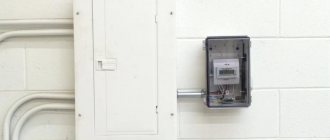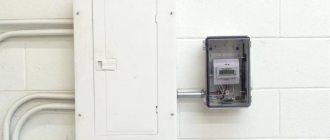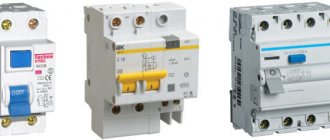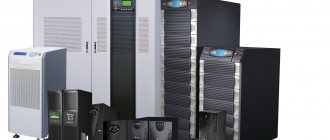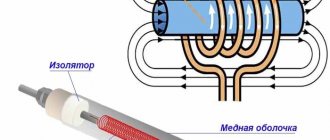An electricity meter is a measuring device for recording the consumption of electricity consumed. Depending on the modification, the device can operate in DC or AC networks. The unit of consumption is kW/h or A/h.
Classification of meters
Counters are usually divided according to three criteria:
- Type of measured quantity.
- Connection method.
- Constructions.
When choosing, you need to pay attention to all three criteria, selecting the optimal device for the required parameters of the electrical network and the level of energy consumption.
Varieties by type of measured quantity
The classification of meters by type of measured value is the easiest to understand even for a person who is far from knowledge of the principle of operation of electrical networks. All devices are divided into single-phase and three-phase. The single-phase electricity meter is designed for connection to AC networks 220 V, 50 Hz. Three-phase devices operate with electrical networks of 380 V, 50 Hz. At the same time, they can carry out measurements when connected to a single-phase network.
Single-phase devices can be found in any apartment or house. They are designed for household use. Three-phase devices are in most cases used at industrial facilities where a three-phase electrical network is installed, required for the operation of powerful equipment. Depending on the modification, three-phase meters may have a three or four wire connection.
Classification by connection method
Based on the connection method, the meters are divided into only two groups. There are direct connection and transformer connected devices. The former are directly connected to the network, while the latter need to be connected to a special transformer, which is connected to the circuit in front of the meter itself.
Varieties by design
Modern meters come in 3 design options:
- Induction.
- Electronic.
- Hybrid.
Induction counter
An induction (mechanical) electricity meter has fixed current-carrying coils inside, creating a magnetic field. The field received from them affects the movable element, which is a disk that works on the principle of a conductor for electric currents. When electricity passes through the disk, it begins to turn around under the influence of the magnetic field of the coils, thereby starting the mechanism with the counting board. The more intense the current passing, the faster the disk rotates. The counting mechanism of the device is designed in such a way that a certain number of revolutions corresponds to a change in one indicator on the dial.
Mechanical devices are losing their relevance because their design is far from perfect against more modern electronic meters.
The disadvantages of induction meters include:
- Inability to take readings remotely.
- Single tariff measurement.
- Low sensitivity.
- Insufficient protection against electricity theft.
Often, induction meters are unable to correctly calculate the level of energy consumed. Quite often, if there is low consumption, for example, when the indicator is on in the charger unit of a telephone or household appliance in standby mode, the meter does not respond at all, although minimal energy consumption occurs. In addition, some modifications of meters have completely opposite problems. When a powerful consumer is turned on, their disk turns over much faster than the actual level of energy consumption.
The advantages of mechanical meters include their truly long service life and complete independence from power surges. They are cheap and quite reliable. But their accuracy class corresponds to a level of 2-2.5%, which is quite low compared to electronic devices.
Electronic electricity meter
The electronic meter works on a different principle. In it, currents act on special electronic elements that convert them into impulses. The number of pulses is proportional to the actual amount of transmitted energy. The reading mechanism can be an electronic or electromechanical device that displays data on an LCD display. Electronic counting elements are suitable for devices that are installed inside apartments and houses. The electromechanical mechanism is used on meters mounted on building facades.
The main advantage of such devices is their high accuracy. They correctly display the amount of energy that was missed for consumers. In addition, their electronic components allow energy accounting at several tariffs. That is, they are able to remember information about how much energy was consumed during the daytime and how much at night. This allows you to pay for consumed electricity at several tariffs, if this is provided for in an agreement with the supplier company.
These devices have a long verification period. Depending on the manufacturer, the meter needs to be verified every 4-16 years.
The electronic meter has in its design a non-volatile clock and counting elements that save data in the event of a power failure. Thanks to this, when turned on after an emergency blackout, all information about the level of electricity used will not be reset to zero. Moreover, such devices have their own software, which automatically adjusts the time, which is important in the case of calculations in several tariffs. Also, such devices have protection against unauthorized access, which records such attempts in the event log.
Electronic meters have a high accuracy class, which is at least 1%. Such devices allow you to remotely check indicators without the need for access to the house. Thanks to this, the inspector does not have to enter the apartment, which is especially convenient if residents are not at home on weekdays. However, an electronic electricity meter also has a drawback, which is expressed in high cost. Repairing such devices is much more expensive than mechanical ones. These devices are very sensitive to voltage changes. In the event of an emergency, it is likely that the device will burn out, which will require its replacement.
Hybrid meters
A hybrid electricity meter coexists, which is a device that combines elements of an induction and an electronic device. The permeability of the energy consumed is read by rotating the disk, and the readings are displayed on an electronic dial. Such meters, unlike purely induction ones, are capable of counting according to tariffs.
Technical parameters of electricity meters
Many meter models, designed to operate under the same conditions, differ in accuracy and other characteristics. The main technical parameter of an electric meter is accuracy. Until 1995, all instruments had a maximum permissible error level of 2.5%. After 1996, the requirements for meter manufacturers were tightened, after which devices with an error of 2% began to be installed for the private sector. At the same time, old-style meters are not uncommon and are still in use, subject to verification. All metering devices currently produced have an error of no more than 2%. You can usually find meters with accuracy classes of 0.5, 1 and 2%.
In addition to error, an important parameter is throughput. Household meters are designed for a maximum consumption level of 5A and should be used only in cases where powerful electrical appliances that consume more energy are not used. If the electricity meter is overloaded, a short circuit may occur. Especially for this purpose, it is equipped with electrical circuit breakers that disconnect the circuit to prevent such consequences. It has become common to install more powerful circuit breakers to prevent emergency shutdowns in order to be able to power more energy-intensive consumers. Such techniques are prohibited and are contrary to safety regulations. If intensive energy consumption is necessary, you need to contact the electricity supply company with a request to install a more powerful meter designed for a current of up to 20A or more if 380V is supplied.
Features of filling
The electricity meter, like any other metering device, is equipped with seals that cannot be broken, as there are fines for this. Single-phase meters have two seals installed. One is tightened on the housing fastening to prevent it from being disassembled, and the second is on the clamping cover. In addition, if the device was removed for verification, additional seals may be installed on it, confirming its suitability and the absence of outside interference after testing its functionality.
Metrological aspects of electric power industry
Electrical energy has long and firmly entered our lives. Nowadays, the lack of access to electricity is considered an emergency.
Ensuring the uniformity of measurements for a huge fleet of measuring equipment is a complex task, the solution of which is carried out by tens of thousands of specialists working in various sectors of the national economy.
If we consider electricity as a product that is produced, transported, sold and consumed, then it should, by analogy with other products, be characterized by a set of parameters that most fully reflect its quality and allow its quantity to be determined quite reliably.
In Kazakhstan, these parameters are defined by GOST 13109-97 “Electric energy. Electromagnetic compatibility of technical equipment. Standards for the quality of electrical energy in general-purpose power supply systems", which establishes the following indicators of the quality of electrical energy:
— steady-state voltage deviation;
— amplitude of voltage change;
— flicker dose;
— distortion coefficient of the sinusoidal voltage curve;
— coefficient of the nth harmonic component of voltage;
— negative sequence voltage asymmetry coefficient;
— zero-sequence voltage asymmetry coefficient;
— frequency deviation;
— duration of voltage dip;
— impulse voltage;
— temporary overvoltage coefficient.
Currently, the fleet of instruments for measuring power quality indicators is just being formed; there are difficulties in gaining access to the necessary measuring equipment.
Today, when a huge amount of electricity is produced and consumed, even a small error in the accuracy of measuring its parameters, especially quantitative ones, entails significant economic losses.
The accuracy of measurements is determined by the technical capabilities of the measuring instruments used. Currently, a large number of different means for measuring electrical energy have been registered, especially electricity meters. On the one hand, this is good, since it is possible to select the desired device. On the other hand, there is a problem with their maintenance and reliability.
Another pressing problem, literally a “modern problem,” is the regulatory and metrological support of automated commercial electricity metering systems (ASKUE), which are currently being actively implemented. At the same time, there is no unified system of regulatory and metrological support for this activity.
According to the Law of the Republic of Kazakhstan “On Ensuring the Uniformity of Measurements”, measuring instruments intended for serial production or import into the territory of the Republic of Kazakhstan in batches and which are subject to state metrological supervision are subject to testing with subsequent approval of the type of these measuring instruments. The decision to approve the type of funds is certified by a certificate, the validity period of which is established upon its issuance. The approved type of measuring instruments is entered into the register of the state system for ensuring the uniformity of measurements.
The production, verification and repair of measuring instruments can be carried out by individuals and legal entities after receiving the appropriate license issued by the authorized state body for standardization, metrology and certification.
Measuring instruments subject to state metrological supervision are subject to verification upon release from production or repair. The list and frequency of verification of measuring instruments, as well as the procedure for its implementation, are determined by the authorized state body for standardization, metrology and certification. Positive verification results are certified by a verification stamp and a verification certificate.
What current should I buy a meter for?
Electronic single-phase meters are available for currents from 5A to 60A. As for three-phase electric meters, they are produced for a maximum current of 50A and up to 100A, as well as transformer connection for a current of up to 100A. In residential apartments the load is rarely 100A, for this reason there is no point in installing transformer meters. However, in some cases there are exceptions, for example, the meter can be designed for a maximum current of up to 80A. But in apartments there is no such consumption, since the actual consumption currents are much lower.
Current strength
If you are building a house, then the project must specify for what current the electric meter must be selected. It also states how much power is allocated to the home. Based on this, you can select the appropriate input circuit breaker. As for apartments, you can select the appropriate meter for a particular current using the cable cross-section. Qualified specialists can help you with this.
Types of electricity meters
The classification of electrical energy metering devices is carried out depending on the following parameters:
- connection type;
- measured quantity;
- design features.
Let's consider each of the points separately. Based on the type of connection, meters are divided into two main types:
- devices with direct connection to the power circuit;
- meters connected to the power circuit via instrument transformers (the so-called “transformer connection”).
The first type of devices is intended for household metering, while transformers are needed for large buildings and enterprises that consume high current (more than 100 amperes).
Depending on the measured value, electricity metering devices are divided into the following types:
- single-phase (for current 220V with a frequency of 50Hz);
- three-phase (for current 380V with a frequency of 50Hz).
It is worth noting that modern three-phase meters, which have an electronic design, are capable of producing single-phase metering.
Depending on the design features, there are three groups of devices for metering electrical energy:
- Induction (electromechanical electricity meters). Devices whose operation is based on the action of an electromagnetic field. Fixed conductors in the form of coils through which current passes create magnetic impulses. They set in motion a special mechanism, which is a movable rotating disk. The amount of electrical energy consumed in induction devices is calculated by the number of revolutions of this disk.
- Electronic (static electricity meters). The operating principle of these devices is as follows: a solid-state measuring element converts incoming analog signals of alternating current and voltage into counting pulses, the number of which indicates the value of the measured active energy. The counting mechanism has an electromechanical or electronic design and, in addition to the measuring element, includes a device for storing the obtained values and a display for displaying the results.
- Hybrid devices. Models of this group represent an intermediate option. They are equipped with a digital interface, but measurements are made using an electromechanical method. Currently, these devices are rare, as they are inferior to electronic electricity meters in price and functionality.
The catalog of the MosEnergoSbyt online store contains a wide selection of single- and three-phase electronic meters from the following: NEVA, Matrix and others. You can find a complete list of devices on the company's website.
Single-tariff or multi-tariff meter
Until relatively recently, all household meters were single-tariff, but today everything has changed and you can choose the tariff that suits you best. At the moment, there are single-tariff, double-tariff and multi-tariff electricity meters.
Single-tariff meters keep records at a single-rate (single-zone) tariff around the clock.
Two-tariff electricity meters account for electricity in two tariff zones - day (from 7:00 to 23:00) and night (from 23:00 to 7:00). The intervals of tariff zones of the day are established by order of the Federal Tariff Service of Russia dated November 26, 2013 No. 1473-e and are determined in astronomical hours according to local time. Since the night tariff is an order of magnitude cheaper than the day tariff, it becomes possible to reduce your costs for paying for electricity, but you need to take into account that the daily tariff under a two-tariff system will be slightly higher than under a single-tariff system.
Multi-tariff meters keep records in three zones: peak zone - from 07.00 to 10.00 and from 17.00 to 21.00, half-peak - from 10.00 to 17.00 and from 21.00 to 23.00 and night - from 23.00 to 07.00. The highest cost of electricity is in the peak zone, the lowest in the night zone.
Since tariffs in different regions of the Russian Federation differ significantly from each other, it is difficult to talk about the unconditional benefit of one or another tariff.
As an example, I will give electricity tariffs in St. Petersburg:
| Consumer categories | Tariff size rub./kWh incl. VAT | ||
| One-part tariff | Tariff differentiated by two zones of the day | ||
| daytime (peak and half-peak) zone | night zone | ||
| 1. Population living in urban settlements in houses equipped in the prescribed manner with gas stoves | 4,12 | 4,29 | 2,47 |
| 2. Population living in urban settlements in houses equipped in the prescribed manner with stationary electric stoves and (or) electric heating installations | 2,88 | 3,00 | 1,73 |
| 3. Consumers equal to the population | 4,12 | 4,29 | 2,47 |
| Consumer categories | Tariff differentiated by three zones of the day | ||
| day zone | night zone | ||
| peak zone | half-peak zone | ||
| 1. Population living in urban settlements in houses equipped in the prescribed manner with stationary gas stoves (tariffs include VAT) | 4,32 | 4,12 | 2,47 |
| 2. Population living in urban settlements in houses equipped in the prescribed manner with stationary electric stoves and (or) electric heating installations (tariffs are indicated including VAT) | 3,02 | 2,88 | 1,73 |
| 3. Consumers equal to the population (tariffs include VAT) | 4,32 | 4,12 | 2,47 |
Basic parameters of electricity meters
The main parameters of electrical energy metering devices include:
- Accuracy class. Technical characteristics showing the maximum possible error in measurements. Until 1996 inclusive, all measuring instruments with which residential premises were equipped had an accuracy class of 2.5 (in other words, the measurement error was 2.5%). In the MosEnergoSbyt online store you can find electricity meters that meet the modern standard in the household sector (with a deviation of no more than 2%).
- Intervalidation interval. During continuous operation, individual elements of the device naturally wear out and cease to perform their functions correctly. As a result, the accuracy class of the measuring device inevitably decreases. Therefore, devices must be periodically checked for accuracy of readings. The time interval from the moment of initial verification (during the production process) to the next is called the inter-verification interval (abbreviated as MPI). This characteristic is calculated in years and indicated in the passport of the measuring device.
- "Tariff". This parameter determines the ability of the electric meter to make measurements at various tariffs (or modes). All electricity meters based on the induction calculation method operate at only one tariff. In contrast, electronic meters are capable of operating according to two (the so-called “day/night” mode) or more tariffs (for example, taking separate readings by season or day of the week).
Calibration interval
When purchasing a new electric meter, be sure to pay attention to the presence of seals with a verification period and the absence of any mechanical damage on them. Please note that the verification year is not entered in full, but only the last two digits.
New single-phase meters must have state verification seals with a validity period of no more than 2 years, and three-phase meters - no more than a year. The device passport must indicate the verification interval, which is counted from the year of verification indicated on the seal. The periodicity of verification depends on the manufacturer, the type of metering device and is approximately 6-16 years for various models; more precisely, you can find out about this from the passport of the metering device.
Classification and types of electricity meters
Electric energy meters can be classified according to the following principles:
1. Based on the operating principle:
- induction
- electronic (static)
2. According to the accuracy class of meters:
- workers
- exemplary
The meter's accuracy class is its greatest permissible relative error, expressed as a percentage.
In accordance with GOST R 52320-2005, GOST R 52321-2005, GOST R 52322-2005, GOST R 52323-2005, active energy meters must be manufactured with accuracy classes of 0.2S; 0.2; 0.5S; 0.5; 1.0; 2.0 reactive energy meters - accuracy classes 0.5; 1.0; 2.0 (GOST R 5242520-05).
3. For connection to electrical networks:
- single-phase (1ph 2Pr single-phase two-wire)
- three-phase – three-wire (3ph 3Pr three-phase three-wire)
- three-phase – four-wire (3ph 4Pr three-phase four-wire)
4. By the number of measuring elements:
- single-element (for single-phase networks (1ph 2Pr))
- two-element (for 3-phase networks with uniform heating (3ph 3Pr))
- three-element (for three-phase networks (3ph 4Pr))
5. According to the principle of inclusion in electrical circuits:
- direct connection of the meter
- transformer connection of the meter:
- connecting the meter to a three-phase 4-wire network using three voltage transformers and three current transformers
- connecting the meter to a three-phase 3-wire network using three voltage transformers and two current transformers
- connecting the meter to a three-phase 3-wire network using two voltage transformers and two current transformers
Energy survey • Energy saving program • Consultation
6. By design:
- simple
- multifunctional
7. By the number of tariffs:
- single tariff
- multi-tariff
8. By type of measured energy and power:
- active electricity (power)
- reactive electricity (power)
- active-reactive electricity (power)
Active power for a 1-phase meter, W: PA1ph2 = UфICosφ
Active power for a 3-phase two-element meter connected to a 3-wire network, W: PA3f3Pr = UAVIACosφ1(UAVIA)+ UСВICCosφ2(UСВIC)
Active power for a 3-phase three-element meter connected to a 4-wire network, W: P3ph4Pr = UАIАCosφ1(UАIА) + UвIвCosφ2(UвIв) + UсIсCosφ3(UсIс)
Counter types:
An electromechanical meter is a meter in which currents flowing in fixed coils interact with currents induced in a moving element, causing it to move at a rate in which the number of revolutions is proportional to the energy being measured.
For example:
Single-phase electric meter SO-505, accuracy class 2.0. Single-phase electric meter SO-1, accuracy class 2.5. Three-phase electric meter SA3U-I670, accuracy class 2.0. Electric meter SR4U-I673, accuracy class 2.0.
Static meter - a meter in which current and voltage act on solid-state (electronic) elements to create output pulses, the number of which is proportional to the measured energy.
For example, a single-phase electricity meter Mercury 201 or Mercury 200.02, accuracy class - 2.0. Or three-phase electricity meter Mercury 230A, accuracy class 1.0. Three-phase electricity meter ALPHA A1R, accuracy class 0.5S.
Multi-tariff meter is an electric energy meter equipped with a set of counting mechanisms, each of which operates at set time intervals corresponding to different tariffs.
Reference Meter - A meter designed to convey the size of a unit of electrical energy, specifically designed and used to obtain the highest accuracy and stability under controlled conditions.
Basic concepts, terms and definitions
Counting mechanism (reading device): Part of the counter that allows you to determine the measured value of a quantity.
The readout device may be a mechanical, electromechanical, or electronic device containing both a memory and a display that store or display information.
The measuring element is the part of the meter that produces output signals proportional to the measured energy.
Current Circuit: The internal connections of the meter and the part of the measuring element that carries the current of the circuit to which the meter is connected.
Energy audit • Energy passport • Energy saving program
Voltage Circuit: The internal connections of the meter, the measuring element part and, in the case of static meters, the power supply part supplied by the voltage of the circuit to which the meter is connected.
Direct connection electric meter (or direct connection): As a rule, a 3-phase electric meter connected to a 4-wire network, with a voltage of 380/220V, without the use of current and voltage measuring transformers.
Transformer meter is a meter designed to be switched on through voltage (VT) and current (CT) measuring transformers with predetermined transformation ratios.
The meter readings must correspond to the value of the energy passed through the primary circuit of the instrument transformers.
Basic concepts of electricity metering
Commercial metering of electricity – metering of electricity for monetary payment for it
Technical accounting of electricity - accounting for monitoring electricity consumption inside power plants, substations, enterprises, for calculating and analyzing electricity losses in electrical networks, as well as for accounting for electricity consumption for production needs.
Meters installed for settlement accounting are called settlement meters.
Meters installed for technical metering are called technical metering meters.
Meters that take into account active electricity are called active energy meters.
Meters that take into account reactive electricity for an accounting period are called reactive energy meters.
A measuring instrument is a technical device intended for measurements.
Measuring complex of electricity metering means - a set of devices of one connection intended for measuring and metering electricity: current transformers, voltage transformers, electric energy meters, communication lines.
Starting current (sensitivity) - the lowest current value at which continuous recording of readings begins
Base current - the current value that is the initial value for establishing the requirements for a directly connected meter
Rated current - the current value that is the initial value for establishing requirements for a meter operating from a transformer
Maximum current is the highest current value at which the meter meets the accuracy requirements established in the GOST R 52320-2005 standard.
Rated voltage - the voltage value that is the initial value when establishing the requirements for the meter.
What to look for when choosing
Before purchasing, you need to find out what specific meter your apartment or house needs. This information is in the specifications for the electrical supply of the apartment, where all parameters are indicated. If there is no document, it is worth determining the voltage (220 or 380 V). For 220 V you will need a single-phase meter, and for 380 V - a three-phase one.
Accuracy class
The indicator indicates the maximum possible percentage error from the largest value during accounting. According to the rules, devices with an accuracy class of at least 2 for an individual are accepted for operation, and for a legal entity - no more than 1. Today meters are produced with KT 0.2, 0.5, 1, 2. According to GOST, the number is indicated on the unit display in a circle.
Maximum/rated current
The maximum current is determined based on the total power of all electrical appliances. The information is in the power supply project; if it is missing, you can look at the panel of the old device.
Single-tariff/multi-tariff
Determines how many tariffs are included in the device. Multi-tariff is suitable for private homes - at night you can switch to increased heating and achieve significant savings.
Fastening method
Two types of fastening are used - bolted or dinrail. The latter is considered universal and is recommended by many experts.
Single-phase/three-phase
Selected depending on the type of power supply in the apartment. If a cable with 2 cores is supplied to the input circuit breaker, then a single-phase meter is suitable. If a cable with 4 cores is used, then a three-phase one is required.
Company manufacturer
Brands such as Energomera, Incotex, Taypit, and ABB have proven themselves on the market. They independently develop and produce products that meet all safety requirements.
Types and classes of electricity meters
Before choosing an electricity meter, you need to clearly define the parameters that distinguish the main difference between one model and another. Moreover, even a superficial acquaintance with modern electronic devices for monitoring electrical energy allows us to conclude that they all differ in the following indicators:
- number of fixed phases (one or three);
- number of tariff regimes;
- recording device accuracy class;
- maximum current load.
In addition, products of this class differ in some design details, depending on the specific manufacturer (the presence of additional functionality, for example).
Let's look at each of these differences in more detail.
What is the working principle
Understanding how an electronic electricity meter works, making the right choice will be much easier. Electronic meters are available in single-phase and three-phase.
Now about each in more detail.
Single-phase electric meter.
This type of meters is used to supply electricity to small retail spaces, offices, private houses and apartments. The power of such networks is 3-7 kW with a voltage of 220V. If we consider that 1 kW of power corresponds to a circuit current of 4.5A, then such a device is designed for a current from 13 to 32 A. Moreover, when choosing an electric meter, its characteristics are indicated on the device panel: maximum current and rated current, for example, 5-40A. This combination has the following meaning. The 5A indicator indicates the rated current, and 40A indicates the maximum. Thus, when choosing an electric meter, it is extremely important for you to understand what this or that designation means.
Connecting a single-phase electric meter
Connecting a single-phase electric meter diagram
Three-phase electric meter.
As for choosing such a device, there are also some nuances here. They are mainly used in private cottage villages, where input is carried out only via a three-phase system. It has also found its application among industrial and domestic buildings. Choosing a three-phase meter for a particular room is very simple. To do this, you just need to find out in the appropriate service, which will even tell you its model. However, you need to be careful here too. After all, you shouldn’t always trust every word you hear. To ensure its quality, you should know some of its basic characteristics. For example, an electronic three-phase meter must have an internal tarifficator that calculates the date and time. At the same time, it generates a load schedule, and also carries out a tariff transition. Moreover, there must be a power profile. It carries out a breakdown and remembers it at a specific time for the maximum power for the reporting period.
Note!
A good electronic three-phase electric meter should have an event log that will record overvoltage and overvoltage in each phase. It also records changes in active and reactive energy, voltage dips and duration of current absence.
Connecting a three-phase meter
Connection diagram for a three-phase electric meter
